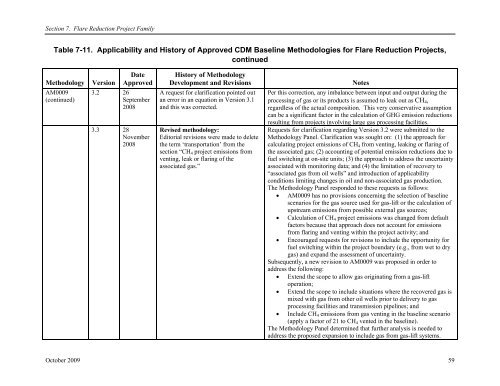Part III: Flare Reduction Project Family - IPIECA
Part III: Flare Reduction Project Family - IPIECA
Part III: Flare Reduction Project Family - IPIECA
Create successful ePaper yourself
Turn your PDF publications into a flip-book with our unique Google optimized e-Paper software.
Section 7. <strong>Flare</strong> <strong>Reduction</strong> <strong>Project</strong> <strong>Family</strong><br />
Table 7-11. Applicability and History of Approved CDM Baseline Methodologies for <strong>Flare</strong> <strong>Reduction</strong> <strong>Project</strong>s,<br />
continued<br />
Methodology<br />
AM0009<br />
(continued)<br />
Version<br />
Date<br />
Approved<br />
3.2 26<br />
September<br />
2008<br />
3.3 28<br />
November<br />
2008<br />
History of Methodology<br />
Development and Revisions<br />
A request for clarification pointed out<br />
an error in an equation in Version 3.1<br />
and this was corrected.<br />
Revised methodology:<br />
Editorial revisions were made to delete<br />
the term ‘transportation’ from the<br />
section “CH 4 project emissions from<br />
venting, leak or flaring of the<br />
associated gas.”<br />
Notes<br />
Per this correction, any imbalance between input and output during the<br />
processing of gas or its products is assumed to leak out as CH 4 ,<br />
regardless of the actual composition. This very conservative assumption<br />
can be a significant factor in the calculation of GHG emission reductions<br />
resulting from projects involving large gas processing facilities.<br />
Requests for clarification regarding Version 3.2 were submitted to the<br />
Methodology Panel. Clarification was sought on: (1) the approach for<br />
calculating project emissions of CH 4 from venting, leaking or flaring of<br />
the associated gas; (2) accounting of potential emission reductions due to<br />
fuel switching at on-site units; (3) the approach to address the uncertainty<br />
associated with monitoring data; and (4) the limitation of recovery to<br />
“associated gas from oil wells” and introduction of applicability<br />
conditions limiting changes in oil and non-associated gas production.<br />
The Methodology Panel responded to these requests as follows:<br />
• AM0009 has no provisions concerning the selection of baseline<br />
scenarios for the gas source used for gas-lift or the calculation of<br />
upstream emissions from possible external gas sources;<br />
• Calculation of CH 4 project emissions was changed from default<br />
factors because that approach does not account for emissions<br />
from flaring and venting within the project activity; and<br />
• Encouraged requests for revisions to include the opportunity for<br />
fuel switching within the project boundary (e.g., from wet to dry<br />
gas) and expand the assessment of uncertainty.<br />
Subsequently, a new revision to AM0009 was proposed in order to<br />
address the following:<br />
• Extend the scope to allow gas originating from a gas-lift<br />
operation;<br />
• Extend the scope to include situations where the recovered gas is<br />
mixed with gas from other oil wells prior to delivery to gas<br />
processing facilities and transmission pipelines; and<br />
• Include CH 4 emissions from gas venting in the baseline scenario<br />
(apply a factor of 21 to CH 4 vented in the baseline).<br />
The Methodology Panel determined that further analysis is needed to<br />
address the proposed expansion to include gas from gas-lift systems.<br />
October 2009 59

















